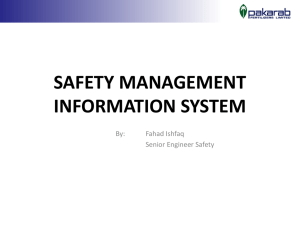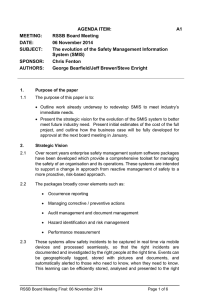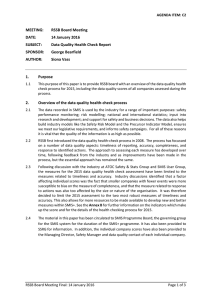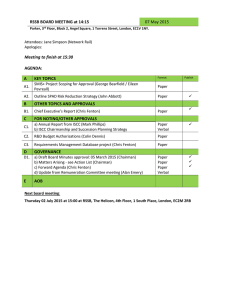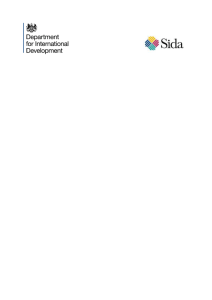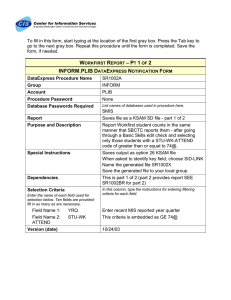SMIS+ Tender Presentation 16 July 2015
advertisement
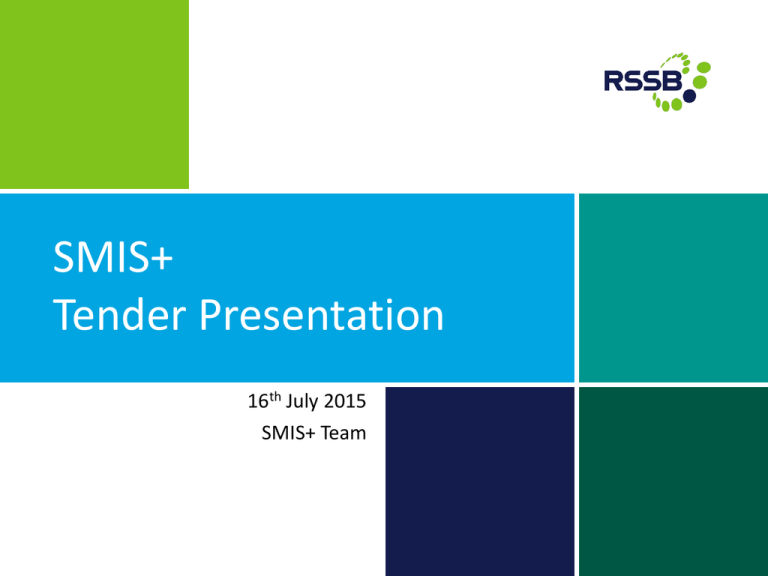
SMIS+ Tender Presentation 16th July 2015 SMIS+ Team Content • Project overview & future vision • Procurement process overview • Implementation overview • Data overview • Future phases • Initial implementation (phase 0-5) requirements 2 SMIS+ Tender Presentation 16 July 2015 House keeping • Fire alarm • Toilets • Lunch • Finish • Questions SMIS+ Tender Presentation 16 July 2015 Project Overview & Future Vision George Bearfield & Jeff Brewer 4 SMIS 5 • Been in place since the late 90s. • Huge success: • Reporting culture • Spin off tools: Safety Risk Model • Recognised as world class SMIS+ Tender Presentation 16 July 2015 SMIS+: Overview Enterprise Safety Management System Software 6 SMIS+ Tender Presentation 16 July 2015 Industry Safety Activity and Strategy RSSB Board System Safety Risk Group (SSRG) Train Operations Risk Group Level Crossing Risk Group People on Trains and in Stations Risk Group National Suicide Prevention Steering Group The risk intelligence that a world class railway needs, efficiently provided to the right people in the right format and at the right time. 7 SMIS+ Tender Presentation 16 July 2015 Data and Risk Strategy Group Road Driving Risk Steering Group (Project) The Vision Commercial & other drivers CSM for Monitoring Safety concern? Review No CSM on Risk Evaluation and Assessment Implement Ye s Scope problem Analyse options Analyse Monitor Select options Make No change? Monitoring safety 8 SMIS+ Tender Presentation 16 July 2015 Demonstrate compliance Determine safety measures Define change Yes Analysing and selecting options Making a change The opportunities Data entry Overall system BI 9 SMIS+ Tender Presentation 16 July 2015 Data quality What do we need to support the vision 10 Data collection Risk modelling and calculation Hazard mapping and bow-ties Safety performance BI Safety CBA and appraisal Risk and hazard management SMIS+ Tender Presentation 16 July 2015 Totality of the modules needed Data collection Risk modelling and calculation Hazard mapping and bow-ties Safety performance BI Safety CBA and appraisal Risk and hazard management SMIS+ (Phases 0 to 5) 11 SMIS+ Tender Presentation SMIS+ (Future Phases) 16 July 2015 SMIS+ and other systems (Future Phases) Totality of the modules needed 12 Data collection Risk modelling and calculation Hazard mapping and bow-ties Safety performance BI Safety CBA and appraisal Risk and hazard management SMIS+ (Future Phases) SMIS+ and other systems (Future Phases) SMIS+ (Phases 0 to 5) 1 SMIS+ Tender Presentation 16 July 2015 Jan 99 Jul 99 Jan 00 Jul 00 Jan 01 Jul 01 Jan 02 Jul 02 Jan 03 Jul 03 Jan 04 Jul 04 Jan 05 Jul 05 Jan 06 Jul 06 Jan 07 Jul 07 Jan 08 Jul 08 Jan 09 Jul 09 Jan 10 Jul 10 Jan 11 Jul 11 Jan 12 Jul 12 Jan 13 Jul 13 Jan 14 Jul 14 Jan 15 Fatalities and weighted injuries per year The next step in safety performance…. 25 Infrastructure 20 Operational incidents Public Behaviour Environmental 15 SPAD Trains and rolling stock 10 5 0 SMIS+ Tender Presentation 16 July 2015 Source: Precursor Indicator Model, RSSB Jan 99 Jul 99 Jan 00 Jul 00 Jan 01 Jul 01 Jan 02 Jul 02 Jan 03 Jul 03 Jan 04 Jul 04 Jan 05 Jul 05 Jan 06 Jul 06 Jan 07 Jul 07 Jan 08 Jul 08 Jan 09 Jul 09 Jan 10 Jul 10 Jan 11 Jul 11 Jan 12 Jul 12 Jan 13 Jul 13 Jan 14 Jul 14 Jan 15 Fatalities and weighted injuries per year The next step in safety performance…. 25 Infrastructure 20 Operational incidents Public Behaviour Environmental 15 SPAD Trains and rolling stock 10 5 A new norm 0 SMIS+ Tender Presentation 16 July 2015 Our main focus for today Data collection Safety performance BI SMIS+ (Phases 0 to 5) 15 SMIS+ Tender Presentation 16 July 2015 Benefits of SMIS+ • Improved efficiencies in recording and managing safety events and investigations. • “Single version of the truth”, with all safety-related incidents and close calls captured and stored in a new common format. • New SMS functionality (to be phased) that would allow industry to operate more efficiently in meeting its SMS responsibilities. • SMIS and close call data entry aligned with the data requirements of the SRM and the Annual Safety Performance Report. • Efficient benchmarking of safety reporting and close calls across organisations including normalisation data. • New BI software that will also allow stakeholders to create local safety performance and close call reports and dashboards. • Easier to link to existing industry bespoke systems. • A significant reduction in the annual support, hosting and on-going development costs through a more easily configurable system which allows RSSB to take on much of the support and administration. 16 SMIS+ Tender Presentation 16 July 2015 Progress to date/work in progress • Industry-wide consultation • High level requirements specification for an integrated SMIS and Close Call system now complete; o SMIS User Group Advisory Panel have been consulted, o Approved by SMIS+ Project Board. • Draft business case presented to RSSB Board in May. • Formal tendering process has now commenced. • Business change and communication planning has commenced. 17 SMIS+ Tender Presentation 16 July 2015 High level plan and next steps 06/07/2015 Issue OJEU Contract Notice 21/06/2015 HLR's approved 01/05/2015 01/06/2015 20/10/2015 Business case approval/award contract Suppliers request to participate 01/07/2015 01/08/2015 Dialogue and evaluation 01/09/2015 01/10/2015 Design Phase 01/11/2015 28/04/2015 31/12/2015 Capture SMIS+ data requirements Plan for Business Change Business Change Data migration strategy Risk reviews Formal consultation 18 01/12/2015 SMIS+ Tender Presentation 16 July 2015 High level plan 01/02/2016 Design phase complete /Build phase starts 30/11/2016 SMIS + Implemented (TBC) Workshops to industry representatives Build /testing/implementation phase (subject to supplier proposal) 01/04/2016 01/07/2016 11/01/2016 30/11/2016 Business change to include : Communication Stakeholder management Training Guidance Definitions Organisational hierarchy 19 SMIS+ Tender Presentation 01/10/2016 16 July 2015 Procurement Tom Deacon 20 Procurement procedure Competitive dialogue procedure Why? Not possible to technically specify the system Benefits tenderers and RSSB by allowing us to discuss potential solutions together, before final tenders are submitted First RSSB will apply the exclusion criteria from the regulations The RSSB will select the top 5 suppliers using the selection criteria Concise dialogue to reduce bid costs Final tenders evaluated against the published evaluation criteria 21 SMIS+ Tender Presentation 16 July 2015 Questions and answers We will cover the basics while presenting today We will cover questions submitted in advance this afternoon Then, this afternoon is an opportunity to ask any further questions After today, if you need to know more in order to request to participate and draft your tender discussion document, please email further questions by 28th July so we can answer before the initial deadline. RSSB will anonymise the questions received and publish questions and answers. 22 SMIS+ Tender Presentation 16 July 2015 Indicative procurement timetable Activity Start Date End Date Time OJEU Contract Notice sent for publication and procurement documents: http://www.rssb.co.uk/about-rssb/working-with-us/supplier-opportunities 08/07/2015 N/A Supplier day to clarify scope, process and answer initial questions from Tenderers 16/07/2015 10:00 16:00 Deadline for Tenderers to submit additional questions before requesting to participate in dialogue. 28/07/2015 13:00 RSSB provide answers to questions 04/08/2015 13:00 Deadline for requests to participate in competitive dialogue 10/08/2015 13:00 RSSB selects Tenderers to invite to participate in competitive dialogue 10/08/2015 24/08/2015 N/A Selected tenderers prepare demonstration and presentation for dialogue 25/08/2015 01/09/2015 N/A Demonstration and dialogue day for selected tenderers (1 day per tenderer during this period) 01/09/2015 09/09/2015 N/A Deadline for submitting updated tenders If required, further clarification questions and answers from either party 15/09/2015 and/or dialogue meetings to discuss if required 14/09/2015 13:00 18/09/2015 N/A Deadline for submitting final tenders 21/09/2015 13:00 Estimated notification of award decision Target contract commencement date (after 10 day standstill) 01/10/2015 N/A 12/10/2015 N/A 23 SMIS+ Tender Presentation 16 July 2015 – Responses please submit a request to participate and tender discussion document please use the checklist provided and comply with document instructions terms and conditions are from the government model IT contract please use the formats requested please submit before the deadline 24 SMIS+ Tender Presentation 16 July 2015 Implementation Jeff Brewer & Rik Kapoor 25 RSSB’s Proposed Implementation Plan RSSB have put together a plan on how we see SMIS+ being implemented. This is based on a target delivery date of October 2016 after which it will then need to be deployed to the GB rail industry. The plan will commence immediately after the supplier has been selected. It is broadly based around the following framework: • Project set-up and planning = Phase 0 • Design & Specifications = Phase 1 • Build which is split into 3 linked phases: • Early System Visibility = Phase 2 • Overall System Visibility = Phase 3 • Complete System Visibility = Phase 4 • Deployment = Phase 5 • Future Phases = Phase 6+ 26 SMIS+ Tender Presentation 16 July 2015 Implementation Plan - Phases 0 to 5 Phase 0: Plan Phase 1: Specification & Design Phase 3: Overall System Visibility Phase 2: Early System Visibility Phase 4: Complete System Visibility Phase 5: Deployment Milestones: Milestones: M-28- Environment(s) ready M-36 - Environment(s) ready M-29 - Completion of all processes and supporting functionality M-30 - Completion of System Administration functionality M-31 - Completionof Customisations / Interfaces M-32 - Completion of Reporting & BI Reports, Dashboards, Models M-33 - Completion of Data Management layer M-37 - User Confidence Testing handover M-38 - User Confidence Testing completed successfully Milestones: M-17 - Environment(s) ready Milestones: M-1 - Initiation complete M-2 - Project Plan complete Milestones: Milestones: M-3 - Data spec complete M-4 - Data Management spec complete M-5 - Reporting & BI spec complete M-6 - Functional spec complete M-7 - Data Migration spec complete M-8 - Architecture Design complete M-10 - Environment(s) ready M-11 - Early visibility of Event Management & Investigation process M-12 - Early visibility of forms for capturing Safety Events M-13 - Early visibility of functionality supporting the processes M-14 - Early visibility of administration of users, roles, permissions M-15 - P2 User Acceptance Testing handover M-16 -P2 User Acceptance Testing completed successfully M-9 - Specifications / Design documents approved Oct Nov Dec Jan Feb Mar Apr 2015 27 M-18 - Further work on processes M-19 - Further work on functionality supporting processes M-20 - System Administration functionality - Setting up organistions M-21 - System Administration functionality - Modifying processes/forms M-22 - Visibility of Customisations Interfaces, Other M-23 - Set-up/Configuration of Data Warehouse M-24 - Early visibility of Reporting & BI Reports, Dashboard M-25 - Visibility of Data Management layer functionality M-26 - P3 User Acceptance Test handover M-27 - P3 User Acceptance Testing completed successfully May Jun 2016 SMIS+ Tender Presentation 16 July 2015 Jul M-39 - Training to central adminstrators completed successfully M-40 - Data Migration of SMIS system M-41 - Release to SMIS Users M-42 - Data Migration of CCS system M-43 - Release to CCS Users M-34 - P4 User Acceptance Testing handover M-35 - P4 User Acceptance Testing completed successfully Aug Sep Oct M-44 - Warranty Period complete M-45 - Support Contract commences Nov Dec Jan 2017 Feb Mar Implementation Plan - Phases 0 to 5 Phase 0 – Plan – Nov 2015 This is the initial activity, where the delivery project is formally started and a detailed plan for the delivery of SMIS+ is produced. Phase 1 – Specification & Design – Jan 2016 This is the key activity where the detailed specification and designs of the SMIS+ system are produced. Phases 2, 3, 4 – Build – Oct 2016 The build of SMIS+ is split over three separate, but interlinked, phases. Phase 2 sees the build of an early version of the system, after which Phases 3 and 4 will continue to extend the delivery, adding further functionality to build the whole system. Phase 5 – Deployment – From Oct 2016 The deployment is the period in which the system is deployed to rail industry users. The current aim is that SMIS+ will be a phased deployment to the SMIS and CCS user communities. 28 SMIS+ Tender Presentation 16 July 2015 Phase 0 - Plan • During this phase the project will be initiated and a project plan for the build and deployment will be produced. Purpose Who will do this? Deliverable 29 SMIS+ Tender Presentation 16 July 2015 • Lead by the supplier in conjunction with RSSB • Project plan to be produced and maintained by the supplier throughout the implementation Phase 1 – Specification & Design • During this phase detailed specification and design activities of the project will be carried out. These activities will then lead to the production of specification and design documents. Purpose Who will do this? • Responsibility of the supplier to produce the outputs but considerable input and support from RSSB Deliverable • Design documents, see next slide 30 SMIS+ Tender Presentation 16 July 2015 Design Documents No Specification/ Design Document 1 Data Specification of the detailed data model for SMIS+ including event categories, fields, attributes and relationships 2 Data Management Specification detailing the data management needed to support SMIS+. This includes processes, data interfaces, security, administration and governance of the data management layer 3 Reporting & BI Specification detailing the reporting and BI required from SMIS+ including reports, formats and data warehouse 4 Functional Specification of the SMIS+ system in terms of its functionality and process. This will use the SMIS+ specification as its input 5 Architecture Design of the architecture in terms of environments, architectures, hardware, and software, for the different environment required for SMIS+ 6 Data Migration Specification detailing how the legacy data from SMIS and CCS systems will be migrated and then used in SMIS+ 31 SMIS+ Tender Presentation 16 July 2015 Phase 2 – Build – Early System Visibility • Initial build of an early version of the SMIS+ delivering event management and investigation processes. • Includes the creation of the data model, along with workflow components that will handle the processes . Purpose: 32 Who will do this: • Supplier activity, however, RSSB will work closely with the supplier team. Deliverable: • Early version of the core processes of SMIS+. • At the end of this phase the system will need to be demonstrated to business and technical representatives across the GB rail industry. This will demonstrate how the system is beginning to take shape. SMIS+ Tender Presentation 16 July 2015 Phase 3 – Build – Overall System Visibility 33 Purpose: • Build of an early version of the SMIS+ introducing all of the modules that make up the overall system. • The system builds upon the version of SMIS+ from Phase 2 and includes more functionality on processes, customisations and integration with the different modules that form part of the overall solution. Who will do this: • Supplier activity, however, RSSB will work closely with the supplier team Deliverable: • Early version of the whole of SMIS+ system. • Early version of SMIS+ that will be demonstrated to business and technical representatives to demonstrate how the overall system links together SMIS+ Tender Presentation 16 July 2015 Phase 4 – Build – Complete System Visibility 34 Purpose: • Complete the build of SMIS+ for all of the modules of the system. • Functionality will be further extended for each of the modules, including reporting and BI, data management and systems administration. All of the remaining processes will be completed. Who will do this: • Supplier activity, however, RSSB will work closely with the supplier team Deliverable: • Final version of the whole of SMIS+ system that will have passed all user acceptance testing. • Final version of SMIS+ that will be demonstrated to business and technical representatives to demonstrate the overall system SMIS+ Tender Presentation 16 July 2015 Phase 5 – Deployment Purpose: 35 • Currently SMIS+ will be deployed to the GB rail industry as a phased implementation, with the system needed to be delivered to the SMIS and CCS user communities. This is subject to industry confirmation. • Supplier activities will need to be carried out in conjunction with the Business Change workstream to align with all deployment activities. Who will do this: • Joint activities with the supplier and the SMIS+ business change & project teams Deliverable: • Key deliverable will be the migration of the data from SMIS and CCS systems • Other activities identified and will include training to the RSSB support and development team SMIS+ Tender Presentation 16 July 2015 RSSB’s Proposed Implementation Plan We (RSSB) have come up with an outline plan to deliver and deploy SMIS+ according to our business drivers. As part of your tender discussion document will be an implementation plan that either confirms our plan or come up with an alternative that can meet the requirements! 36 SMIS+ Tender Presentation 16 July 2015 Data Overview Paul Sizer 37 SMIS+ Conceptual Structure Safety Event Injurie s Human error SMIS+ Tender Presentation Oth er Recommendations Damag e System failure 38 Animals 16 July 2015 Actions Event reporter Asset owner Event owner Tracking Attachment s Organisation unit Involve d person Videos Assets Investigation Images Ac ts Workforce Operational Personal Condition s Environment Occurrence s Non-workforce Peopl e Sub events Contributory Post event Other matters concerning safety Causal Performance shaping Causation factors Items Documents Event chain Generi c Event and causation chain - concept Visual representation of what happened and why System navigation via the chain (showing connected involved items) Reporting across the chain 39 SMIS+ Tender Presentation 16 July 2015 Event and causation chain – visual concept Performance shaping incident factor factor factor Post event incident factor Causal incident factor Causal incident factor Causal incident factor Sub event Performance shaping incident factor Each node will contain a number of fields 40 Sub event SMIS+ Tender Presentation 16 July 2015 Human error System failure Key Causation factor Sub event Event and causation chain – example – a train striking an animal with a derailment factor factor Delay in calling ambulance Lack of vegetation in field Animal on the line Failed to follow procedure Poor planning 41 Lack of time SMIS+ Tender Presentation 16 July 2015 Open gate Train striking animal Derailment Train striking animal with involved items Person – train driver Lack of vegetation in field Injury – broken arm factor Animal on the line Train striking animal Delay in calling ambulance Derailment Open gate Poor planning Lack of time Animal Failed to follow procedure Person – infrastructure worker 42 SMIS+ Tender Presentation 16 July 2015 Train Damage Key Causation factor Sub event Involved item Consequenc e Sub event templates – train striking animal factor Train striking animal Users will start an event with a sub event type Train contact with item Sub event types will be based on a component class. These are building blocks which may be used across multiple sub event types ` Animal Train factor Contact mode = ‘strike’ Event recorders will not have access to ‘brown’ component classes, but may want to see the logical structure as guidance. 43 SMIS+ Tender Presentation 16 July 2015 Sub event types will also have a number of mandatory objects involved And some fields will be pre-populated Users will not be able to remove mandatory objects or amend prepopulated fields. Initial data entry Safety event categorisation Date and time One or more Narrative Event recording Sub-event Location item Sub-event classification For each mandatory item Item classification Event customisation 44 Location geo point SMIS+ Tender Presentation Add any injuries 16 July 2015 Add person Add injury details Event recor Sub-event classification For each mandatory item Item classification Event customisation Add any injuries Add any additonal items Record any damage Add attachments 45 SMIS+ Tender Presentation 16 July 2015 Add person Item classification Record damage on relevant item Add injury details Example: Signal Passed At Danger • 3/12/14 23:10 Location • SN109 • Signal • Fixed asset Date/time Events System knows what SN109 is and where it is 46 SMIS+ Tender Presentation • Group • Operational • Event type • SPAD 16 July 2015 Other assets • Train • Workforce (driver) Example: Signal Passed At Danger General • Description • Narrative Sub event Involved 47 SMIS+ Tender Presentation • Overrun length • Risk ranking • Person – Workforce – Driver – Name – Org A • Train – 6A27 – Org A – Freight • Signal – SN109 (from register). TPWS status (manual) 16 July 2015 Sub-events with items TPWS loop factor Train speeding Train 48 SMIS+ Tender Presentation Signal factor TPWS demand Person – train driver 16 July 2015 Train SPAD Person – train driver Train Person – train driver Event management Causation Investigate Add causation factors Recommendations and actions Link to causation factors Tracking Finalisation 49 SMIS+ Tender Presentation 16 July 2015 Sub-events with items TPWS loop factor Train speeding Train 50 SMIS+ Tender Presentation Signal factor TPWS demand Person – train driver 16 July 2015 Train SPAD Person – train driver Train Person – train driver Add causation factors Sunlight Driver training adequate Broken gritter 51 TPWS demand Train speeding SMIS+ Tender Presentation Low adhesion 16 July 2015 SPAD Wrong signal number reported Link recommendations Sunlight Recommendation 1 Driver training adequate TPWS demand Train speeding Recommendation 2 Broken gritter Low adhesion Recommendation 3 52 SMIS+ Tender Presentation 16 July 2015 SPAD Wrong signal number reported Future Phases 53 CIRAS Paul Russell 54 Risk Models and Tools Marcus Dacre 55 Future requirements: beyond phase 5 H11 Risk Management H12 Risk Assessment H18 Bow Ties 56 SMIS+ Tender Presentation 16 July 2015 What we have now: Safety Risk Model A structured representation of the risk arising from the operation and maintenance of the mainline railway Includes: - Train accidents - Accidents in stations - Accidents on or about the track - Accidents in yards, depots and sidings - Trespass and suicide 57 SMIS+ Tender Presentation 16 July 2015 What we have now: Safety Risk Model Risk = frequency x consequence Frequency Consequence 1 FWI = or Fatalities and Weighted Injuries 58 SMIS+ Tender Presentation 1 fatality 16 July 2015 or 10 major injuries or or or 200 1,000 200 1,000 Class 1 Class 2 Class 1 Class 2 minor injuries shock/trauma events What we have now: Safety Risk Model Results presented by: Hazardous event and precursor Passenger slip, trip or fall on stairs due to being under the influence Derailment of passenger train due to axle failure There are 131 hazardous events and almost 3,000 precursors. People affected Passenger 59 SMIS+ Tender Presentation Workforce 16 July 2015 Public What we have now: SRM Risk Profiling Tool Allows the risk profile to be localised Incident data National Risk Profile (SRM) Exposure data (normalisers) Expert judgement 60 SMIS+ Tender Presentation 16 July 2015 Local Risk Profile What we have now: Other risk estimation tools • TSD Analysis Tool (cost-benefit analysis) • Topic-specific risk estimation tools • Need to interface with Network Rail tools More information on current RSSB risk models and tools can be found at the Rail Risk Portal: http://www.rssb.co.uk/rail-risk-portal 61 SMIS+ Tender Presentation 16 July 2015 Work in progress: Geo-referenced Safety Risk Model Research project (T972) is developing a pilot GeoSRM User-friendly interface Linked to asset information Highly localised 62 SMIS+ Tender Presentation 16 July 2015 Work in Progress: Platform-train interface (PTI) Risk Assessment Tool Research project (T1029) is developing a tool • For assessing PTI risk associated with the station, its platforms and the trains that stop at them • User enters information about station • – This defines the questions to be completed User answers a series of questions about risk influencing factors / risk controls • – Qualitative and quantitative information Outputs: summary information (including areas for improvement), station risk assessment and information for local instruction • Allows sharing of information and benchmarking 63 SMIS+ Tender Presentation 16 July 2015 Future Plans Further development of models and tools Zone 1: 2015 Zone 2: 2016 Zone 4: 2017+ Zone 3: 2017 Data Risk Profile Tool Predictive Risk Tool Data sources identified Outputs Risk Report Normalization data Predictive data Training SRM Issues Log Parameterized SRM framework Define Activities CCT SRM SRM Structure Localization restructure Taxonomy GeoSRM RPT New Structure QA Deep Dive Recommendations SMIS+ Reqs Data refresh Whole model Parameterization Data cut-off Analysis Industry Health & Safety Strategy Identifying services CBA Tool User interface SRM Update SRM analysis philosophy review SMIS+ Phase 1 Outputs to CBA DfT franchises HEM/HEN Automation User interface GRIP process CSRM Initial Industry Plan CBA Mapping options Guidance Web Portfolio Gap analysis and dependencies 64 SMIS+ Tender Presentation Training modules 16 July 2015 Product Summaries Future Plans: Risk assessment process tools • Templates (with ability to attach files) • Business process workflow For more information see the GE/GN864x series on http://www.rssb.co.uk/railway-group-standards 65 SMIS+ Tender Presentation 16 July 2015 Bow ties / risk controls Library of industry bow ties available Can be adapted for local risk assessments Integrated with risk tools Threats, top events and controls map to SMIS+ reporting categories 66 SMIS+ Tender Presentation 16 July 2015 NIR-Online & Rail Notices Andy Tandy 67 Topics covered Background – NIR-Online Creation of NIR-Online Creation of Rail Notices Demonstration of Rail Notices 68 SMIS+ Tender Presentation 16 July 2015 Background – NIR-Online (Original system) A defectWritten Report is discovered by a Nominated Competent Person National Operations Centre Operators Suppliers Industry Monitors 69 SMIS+ Tender Presentation 16 July 2015 The Creation of NIR-Online (Present system) National Operations Centre Operators Suppliers Industry Monitors 70 SMIS+ Tender Presentation 16 July 2015 NIR-Online (System Overview) 8250 (NIR) is raised National Operations Centre Recipient of 8250 TOCs NOC Process Recipient of 8250 Suppliers Recipient of 8250 71 SMIS+ Tender Presentation 16 July 2015 Industry Monitors Rail Notices (System Overview) Recipient of 8250 8250 (NIR) is raised NOC Process WSA is raised NOC Process Recipient of Both Recipient of WSA 72 SMIS+ Tender Presentation 16 July 2015 Rail Notices Templates • • • • • • • 73 SMIS+ Tender Presentation NIR 3350 Dangerous Goods Sectional Appendix Signal Box WON C WON D Workforce Safety Alerts 16 July 2015 Demonstration 74 SMIS+ Tender Presentation 16 July 2015 Key points - NIR-Online and Rail Notices are currently two separate systems with a shared login (dependant upon permissions) - Rail Notices contains several templates which each have different usage/access permissions - Both systems record the time taken for companies and/or users to acknowledge reports 75 - Different companies may have different response SLAs - Only certain users may have the ability to raise a report. SMIS+ Tender Presentation 16 July 2015 Health, Safety & Wellbeing Jeff Brewer 76 Initial implementation (phase 0-5) requirements Rik Kapoor 77 Requirements Introduction Overview Event Management & Investigation process System Administration Reporting and Business Intelligence Future (Post Phase 5) functionality Data Management Non functionals 78 SMIS+ Tender Presentation 16 July 2015 Requirements – Overview SMIS+ requirements are subdivided into a FOUR inter-related functional areas, known as modules. These are: • Event recording & management • Investigation • Recommendation & actions Event Management & Reporting Investigation & BI process • Reports, charts • Dashboards • Data mining models • Advanced modelling • Big Data analytics • Publications Non functi onal System • Workflow configuration • Forms, Business Rules • Users, Roles, Permissions • Organisation hierarchy 79 SMIS+ Tender Presentation Administration 16 July 2015 Data Management • External data sources • Asset, train, other data • Transformation of data • Availability to data Event Management & Investigation process - 1 Implementation of configurable workflow functionality in order to: – Allow safety events to be collected via web and mobile applications – Ability to have an electronic map overlayed with asset data e.g. signals – Support the event recording, management and investigation processes – Challenge data quality issues via a change request process – Ability to hold a number of levels of investigation, ranging from no investigation to formal industry investigations – View linked safety events, causes and consequences as an EVENT CHAIN – Log recommendations and track associated actions after investigation 80 SMIS+ Tender Presentation 16 July 2015 Event Management & Investigation process - 2 Implementation of other SMIS+ functionality in order to: – Emulate existing interfaces with SMS / CCIL to bring in incident data – Create new interface with existing company systems for close calls – Ability to have a complete audit trail of all transactions – Have a general task management capability not linked to any process steps 81 SMIS+ Tender Presentation 16 July 2015 System Administration - 1 Implementation of highly configurable process related functionality to: – Maintain flexible workflows that can be easily updated and deployed – Easily deploy modifications to web and mobile applications – Maintain the configuration of forms and business rules to support processes Maintain the system usage: – Maintain user access rights: user, group, role permissions – Delegate limited administration directly to the organisations so that they are able to: Maintain users, groups, roles & permissions for organisation Set up departmental, functional, geographic hierarchies Manage notifications and escalations for an organisation – Interface with Network Rail’s organisation structure for NR only 82 SMIS+ Tender Presentation 16 July 2015 System Administration - 2 Other administration functionality to: – Manage the other modules in terms of access control and security: Data Management Reporting and business intelligence – Ability to view audit and other administrative logs – Ability to carry other administrative activities Global system activities e.g. notifications Archiving of data Data transfers across environments 83 SMIS+ Tender Presentation 16 July 2015 Reporting and Business Intelligence - 1 Implementation of data warehouse that will support the reporting and BI capability that can – Store and maintain safety event and multiple reporting data sources e.g. reference data, normalisers, organisational specific, rail/non rail data.… – Maintain live and snapshot data (that cam be edited if necessary) Implementation of a powerful reporting and BI toolset that has the capability to: – Create views of data for specific user groups – Generate reports, charts, graphs to a high level of sophistication – Generate real-time interactive dashboards – Generate multi dimensional data to allow drill through and data mining – Ability to report across the Even Chain – linked events, causes, consequences – Push interactive reports, charts to external data consumers 84 SMIS+ Tender Presentation 16 July 2015 Reporting and Business Intelligence - 2 Implementation of reporting and BI tools for analysis and visualisation purposes: – Analysis of safety events on an electronic map e.g. safety hotspots – Report animations of data across time Ability to package and distribute report publications (e.g. ASPR) – Package up reports, charts into a single publication – Add textual commentary to the publication – Distribute publications via a process workflow Ability to move across to predictive and big data analytics in the future: – Big data analytics of safety data combined with multiple data sets, including maintenance, sensor and other unstructured data (messages, tweets) – Ability to develop machine learning algorithms and models 85 SMIS+ Tender Presentation 16 July 2015 Data Management Implementation of a “Data Management layer” that will support SMIS+ and : – Receive of external data via interfaces, file transfers or manual uploads – Receive variety of data sources needed for the other SMIS+ modules including: Fixed asset data – signals, level crossing, bridges, stations Train data feeds – train running, train consist Other data needed in the warehouse (normalisers, rail/no rail data) – Ability to transform the incoming data into data sets required by the other modules of SMIS+ – Full control of all data in the layer by applying version control and audit logging 86 SMIS+ Tender Presentation 16 July 2015 And finally, a few words regarding the non-functionals Performance is key as this will be a system delivered to a large user base (60K mobile users, 28K web users) Scalable platform to support no loss of performance and future growth (difficult to even provide current sizing as some modules are new) High availability system (during main business hours) Secure system that must prevent unauthorised access (web and mobile) Need to support multiple environments (dev, test, prod, support ++) Flexible system to all development future APIs (future connectivity) Able to work across range of web and mobile platforms (past and future) Intuitive in determining and rectifying performance and scalability issues (needs to be proactive) Ability for backup, archive and data transfer (in order to manage the system) 87 SMIS+ Tender Presentation 16 July 2015 Future (Post Phase 5) functionality Build on the capability of the SMIS+ so that it is able to incorporate further processes and system functionality, including: Risk Management, Assessment and interfacing for Bow Ties Risk Assessment Audit and Inspections Training and Competence Lessons Learned Change Management NIR Online, Rail Notices, CIRAS Health & Well Being Future integrations (for some of the future phases) Document Management (EDMS) 88 SMIS+ Tender Presentation 16 July 2015 Requirements – Our conceptual view Event Management and Investigation Process Reporting & Business Intelligence Data from External systems Incident Logs and Close Calls Outputs Web Services Analytics Safety Data Event Management Data Data Quality Interface with Data Repository Re Data po si t o ry r t fo ty es Safe qu Re ional dit Data d a Safety Events Investigations Recs/Actions Legacy SMIS Organisation Specific Data Reference Data Reporting Admin Data Event Management process g ep o & rtin R Forms Workflow Business Rules System/ Process Audit Train Consist Faults Reports Data Pu b Extra c lica tio n ts s Fixed Assets Reporting Normalisers Organisation specific Legacy Persist incoming data sources Notifications Escalations 16 July 2015 Data Repository Aggregate, Consolidate, Transform data sources Upload data sources via interfaces / manually Fixed Asset Train Operation Data Data Train Running / Vehicle SMIS+ Tender Presentation Reporting Dashboards Data Management Stations Platform Signals Buffer Stops Bridge TPWS Track Switches 89 s Machine Learning BI Train Running Management of Reporting & BI / Data Management Layer Organisation structure User access Roles/Permissions …... Cube Data Management Event Management process Organisation Structure External Data Interface Data from other systems Data view 3 Data view n Normalisers Systems Administration Processes Configuration Maintenance Data view 2 Reporting & BI Data Collection Recommendation & Action Tracking Data view 1 Reporting, BI, Analytics Tools Investigation Creation of Data Views Event Recording & Management Extraction, Load, Transform External Data Interface Safety Data tive dic Pre odels m SMIS+ Data Warehouse Ad Syst mi e m nis s tra tio n Re Data po si t o ry Safety Data Desktop & mobile devices Reporting Data Normalisers Common & Organisational Data NR Fault Data External Data Source Types Legacy Data Legacy Systems Web Services SMIS CCS Thank you

